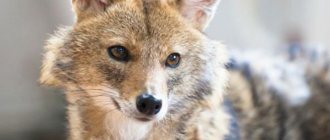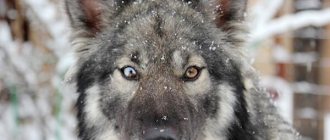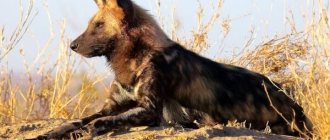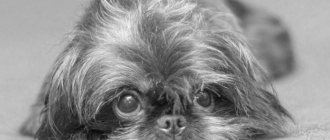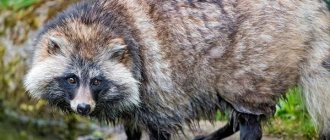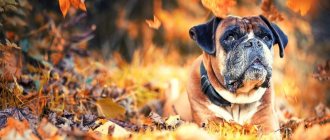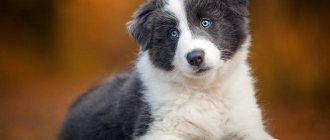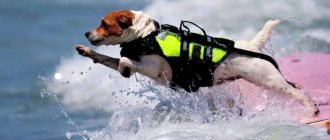Care and maintenance
Caring for a shawl is almost the same as caring for a husky.
During the molting period, the coat is carefully combed out; they shed, like ordinary dogs, twice a year. The dog should be wormed once every three months. During the warm season, your pet's fur should be treated with a special anti-tick product.
Dogs are not afraid of water and enjoy bathing. Shalaika should only be bathed when necessary.
The Shalaika's diet is almost the same as that of other service dogs. The diet must include meat, sometimes fish, cereals and vegetables, almost everything and, of course, clean fresh water.
History of the Shalaika breed
In Russia, the shalaika, or as it is also called “Sulim’s dog,” was shown to the public for the first time at the end of 2022. They introduced the pet as an assistant for serving in the Ministry of Internal Affairs.
The creators of the breed initially planned to cross a wolf with a husky, but after careful research they changed their minds. The main advantage of the jackal over the wolf is its sense of smell; in the jackal it is much more developed. We should also not forget that the jackal is an omnivore. They eat not only meat, but also berries. Due to this, “Sulim’s dog” is able to distinguish different types of drugs, including those of plant origin.
It was not without reason that the Nenets Laika was chosen to cross two different animals. The fact is that the husky of this breed is the most frost-resistant dog among all other candidates for crossing. It was difficult to bring two animals together; they were hostile to each other. The breeders decided to go a different route; they gave the bitch the huskies of three jackal puppies that were born. For animals to grow up together and form friendships. After such cunning actions, the pets made contact and the time came for the breeders for long-awaited experiments.
The first generation of dogs turned out, as expected, not entirely successful. Still, the character of the wild animal made itself felt; the dogs were very aggressive and could not be trained. The breeders did not give up; by crossing the resulting dogs, they bred a third generation, and then a third. After each time the pets turned out better and better. The dogs behaved more and more appropriately, chewed their food slowly, and perceived people differently. All this lasted for seven long years, but the end result could not but rejoice. Currently, about forty specially trained dogs serve at different airports across the country.
Education and training
They take training very well; they even show a desire to learn. They grasp everything on the fly, which is understandable because their level of intelligence is the same as that of German shepherds. Shalaikas work like other service dogs for praise and treats.
When training a shawl, you cannot show aggression or superiority; the animal will not recognize this. Cultivating love and devotion is also not recommended.
Health and illness
Shalaika’s health is good, the dog is able to work normally in severe frost -40 and vice versa in very hot weather +30. The immune system is strong, there are no hereditary or congenital diseases. To prevent your dog from contracting diseases, you need to get annual vaccinations.
Character
Shalaikas have a complex character. Since each of them contains jackal genes, they are not loyal or affectionate to the owner. This is correct, because shawls were not “conceived” as companions and pets in principle, their task is to serve for the benefit of the security of the state, and they fulfill it perfectly.
Shalaikas are careful and reserved with people. Sulimov’s dog is not nearly as friendly and affectionate to its owner as its ancestor, the reindeer-breeding Nenets Laika; it is willful and independent.
The genetic memory of quadroons preserves not only the jackal’s fear of people, but also the wariness of the reindeer race. They have been shot for many years in the tundra, so when they see a person with a gun or a stick, they can “pass”. Such dogs are not hired to work in the gym, but they work in laboratories. Most shalaikas prefer to maintain a distance of 40 steps from suspicious people - shooting distance.
Sulimov's dog is fearless, brave, and active. Their mobility and energy require constant physical activity. Shalaika puppies are unusually nimble, they love to play, but as they grow up, they lose this quality, acquiring seriousness and severity.
The lifespan of a Shalaika is 14 years; they “retire” at 12. After leaving service, the dogs are given homes to new owners. It is impossible to buy a puppy; you can only buy a dog of retirement age or one that has not passed the certification procedure. All dogs of this breed are the property of the airlines and are not sold to other countries or to private owners, with the exception of those listed above.
It is also known from dog handlers involved in training quarterrons that due to the unique acuteness of the animals’ sense of smell, a large number of orders have been received for them from other countries, but there are no plans to sell them anywhere other than Russia. The Shalaikas traveled outside Russia many times on business trips, where they proved themselves to be the best. They also cooperate not only with Aeroflot, but also with the police. Their sense of smell is truly unique - during a test test, the dog makes a mistake one time out of two hundred.
Description and features
The first candidate for participation in hybridization was the common jackal. It is often called the Asian jackal. The animal is the size of an average dog. At the withers, the height does not exceed 40-50 centimeters, weight reaches 8-10 kilograms. Outwardly it resembles a small wolf. Thanks to his high legs and not too dense physique, he looks almost slender.
The range of the Asian jackal extends from Indochina to the Balkans. Recently, there has been an expansion of habitat areas to the north, including Kazakhstan and the southern regions of Russia. The successful expansion of living space is partly due to the lack of fear of anthropogenic landscapes: towns, cities, industrial facilities.
The jackal eats a very varied diet: from carrion to fruits and berries. This fact suggests that the animal’s sense of smell is not specialized and responds to the smell of objects of different origins.
The second candidate for obtaining a hybrid was the Nenets reindeer-footed husky. The dog coexisted with humans for a long time in the Far North. Its main habitat is the Yamal Peninsula.
The inaccessibility of the habitat helped maintain the purity of the animal's blood. Interaction with people in the North has developed a special character. There is a willingness to cooperate, but there is no special affection or love characteristic of other domestic dogs.
The Nenets Laika, due to obvious anthropophobia and inappropriate size, was initially crossed with the Wire Fox Terrier. These dogs have good trainability, affection for their owner, and a fair amount of recklessness.
For subsequent selection, a set of necessary character traits and exterior parameters was determined. The mixed breed obtained from mating a husky and a fox terrier fully corresponded to them.
A cross was carried out between a jackal and a half-breed husky. The resulting hybrid became the basis for further breeding of Sulimov's quadroon. They inherited all the positive qualities of the breeds that participated in the breeding. Sulimov’s dog in the photo does not reveal its semi-wild origins and looks quite civilized.
For now, the hybrid remains a bastard. That is, it has not received recognition as an independent dog breed, despite the pronounced individual qualities that have been established over many generations.
Dogs work effectively in cold and hot weather. The temperature range from -30 °C to +40 °C is quite acceptable for the hybrid. Shakalaikas have good health and can work intensively for 10-12 years. Their sense of smell surpasses that of all known search dog breeds.
Shalaika, or Sulimov's dog - a new Russian search breed
in addition to air travel, it is known for having developed and recently officially registered a new breed of bloodhounds on December 19, 2022. She is called “Sulimov’s Dog” or “Shalaika”.
The name of the breed “Shalaika” is made up of two words that explain its origin: “jackal” and “laika”. There is even a comic nickname “shabaka”. It is also called “jackalika”, quarterron (in the hybrid, a quarter of a jackal is a quart).
And “Sulimov’s Dog” was named in honor of the scientist, author of the idea and chief breeder of the security service.
Aeroflot needed a bloodhound to inspect luggage, search for explosives and other prohibited cargo, endowed with special qualities: a keen sense of smell, unpretentiousness to conditions and small size.
Klim Sulimov took up the task of breeding such a breed.
The breeding plan was developed back in 1975, and the first dogs entered the search service in 2002. Representatives of the Nenets reindeer husky and Central Asian jackal breeds were selected for crossing. These two types had the qualities necessary for the job.
The Reindeer Laika (Nenets Spitz) is an unpretentious dog capable of working in the extreme conditions of the Far North at -50, -70 degrees.
Her sense of smell is one of the best among canines.
The Central Asian jackal retains an exceptional sense of smell and performance in very hot conditions (up to +50 degrees).
But its wool is not suitable for working in the cold.
The resulting breed has a “super sense of smell” and gives even a shepherd a head start.
Thanks to its small and peaceful appearance, the dog does not instill fear in passengers; when passing through the security check rows, it equally carefully examines all people and their luggage. And its endurance allows it to work in all climatic zones of our country at temperatures from -70 to +50.
It was quite difficult to cross a freedom-loving jackal with a dog. For this purpose, the animal’s puppies were placed in reindeer husky to be fed, so that the young individuals would become “friends” among the dogs. Jackals from the wild flatly refused to mate with a dog.
The resulting mestizos were very difficult to train, so they were re-crossed with the Nenets Laika. The result was dogs that were only a quarter related to jackals.
Thanks to their excellent sense of smell, shalaikas can easily find weapons, explosives, drugs or missing people.
Aeroflot currently employs 50 dogs. These dogs are wrong in one case out of two hundred.
Criminologists are increasingly attracting shalaks for their work, and Western dog handlers are also showing interest in this breed.
It is currently impossible for a lover to buy such a dog for himself. Few of them have been bred and the selection process is still ongoing. This dog is not suitable as a companion - the jackal genes make themselves known. This breed was deliberately formed so that it does not become attached to one owner at all (to ensure uninterrupted checking of luggage belts, working with different dog handlers), but is distinguished by excellent intelligence and trainability.
Our days
Jackalayas began to be used as search dogs only in 2002. Before this, quadroons were used by the KGB in the laboratory of the ECC of the USSR Ministry of Internal Affairs, after which exactly twenty-five individuals were sent to Sheremetyevo, where most often they had to look for dangerous explosives, something that the equipment would not see. In 2022, the jackalaika was added to the list of official breeds of the Russian Federation by the Russian Canine Organization. In fact, breeding of this breed is still ongoing. Unfortunately, you will not be able to buy such a pet dog for yourself, but it is difficult to call him a pet, the jackal genes do not sleep.
Breeding work
Such a breed as the Sulimov dog was bred as a result of the work of a biologist. It took Klim a long time to come up with a hybrid that met all the requirements. The first brood, obtained as a result of crossing a jackal and a dog and fed by Nenets huskies, was distinguished by its impressive size, external characteristics characteristic of wild animals, as well as an unbalanced character.
Feeding a dog, according to the breeder, was supposed to imprint its image and make it predominant, determining belonging to this particular species. And yet the first mestizos were quite aggressive, unsociable and difficult to train.
Next, it was decided to cross the hybrids again, but with huskies, so that the jackal genes would be only 25%. But even after this crossing, problems arose, since some of the puppies were very wild and did not accept people, including the dog handlers involved in training. Further selection work made it possible to minimize negative qualities and obtain a hardy search dog ready for work.
External characteristics and habits
Sulimov's dogs are relatively small and very agile. Height is about 40-50 centimeters, average weight is 14-15 kilograms. In appearance there are features of both a husky and a jackal, which is clearly visible in the photo. The muzzle is elongated and pointed, the body is not very long and well developed, the hind limbs are somewhat shorter than the forelimbs. The ears are pointed, reminiscent of a wolf. The muscular system is perfectly formed and developed, the ligaments are incredibly strong, like the entire musculoskeletal system.
The breed has a rather thick and coarse coat; it is usually brown in color with light spots. There is a light spot on the chest, and the tips of the paws, as a rule, are also light.
Character traits
Sulimov’s dog has a difficult character; it certainly will not become a true friend and will not become attached to its owner, which is due to the genes of wild jackals. The tasks of this breed are completely different, and representatives cope with them perfectly. So, they learn well, and at an early age they even show interest in learning new skills. But the main incentive for them is encouragement in the form of some kind of treat; such dogs do not require the approval of a trainer or dog handler.
Sulimov's dogs do not become attached to people and even treat their owners rather coldly, maintaining a certain distance. This breed is distinguished by its willfulness and independence; its representatives are independent and often isolate themselves from other animals, but calmly communicate with their fellow tribesmen, and sometimes showing amazing qualities of mutual assistance.
Sulimov's dogs are fearless and brave, active, very mobile and energetic, they quickly carry out all commands, and at an early age they love to play, and with any objects. The animals cope well with their tasks.
Training
Such animals lend themselves well to training, but you should not show aggression or intolerance while learning new commands. Explain tasks clearly and reward your dog with treats. But there is no need to prove your superiority; anyway, the representative of the breed does not recognize him, just like human love and affection.
How to care for such a dog?
Complicated grooming is not required; it is enough to comb the coat regularly and comb it out during shedding, as well as carry out preventive treatments against worms, ticks and fleas. Nail trimming is unnecessary and unpleasant for your pet, so it is best avoided. Sulimov's dog can be bathed as it gets dirty; most representatives of the breed are not afraid of water.
Nutrition
The diet should include meat, fish, cereals, as well as fruits and vegetables, that is, everything that huskies and jackals usually eat.
Sulimov's dog is an amazing hybrid of a jackal and a husky, and now you know much more about it.
Where to buy a Shalaika puppy
The only place where these super-sleuths are bred is the Aeroflot nursery, which is located near Sheremetyevo Airport. It is quite large, covering an area of about 2 square meters. km. There are about 50 working dogs and no more than a dozen veterans on site.
Shalaika, who retires, usually finds a place in good hands. Many are being held by security officers. The same fate awaits dogs that for some reason cannot work. We do not sell puppies. From birth they belong to the airline and are trained for detective work.
Dogs are not sold abroad and even those unfit for service are not given away. True, the shalaikas more than once went on business trips, where they showed their best side.
Thus, the only way to get a Shalayka is to adopt an adult dog from a kennel that has not been certified or has retired.
Price
The Aeroflot nursery does not sell Shalaika puppies. The price of adult trained detection dogs has not been disclosed. Klim Sulimov admits that they cost like a Mercedes.
Russian-European
A hunting dog of a square format with a lean, muscular build. In height, males reach 52-58 cm, and females 50-56 cm. Representatives of the breed weigh 18-25 kg. A distinctive feature is black and white or pure black colors. Outwardly, the most sophisticated and graceful Laika. They hunt any game, but require some preparation. They can serve as guards.
Unpretentious pets that can adapt to life in a city apartment. The best option would be an enclosure. Animals need to move a lot and actively, hunt, run. It is necessary to provide the dog with proper physical activity.
The cost of Russian-European Laikas depends on their pedigree and working qualities. For a middle-class pet you will have to pay from 15 to 20 thousand rubles. If the dog is mature and trained, the price increases.
Choosing a puppy and price
Shalaika puppies need early socialization, otherwise the dog will be overly cowardly.
It is not possible to buy a jackal dog puppy for private ownership. These animals are bred exclusively for work.
Theoretically, choosing a puppy is quite difficult - the breed does not have strict color requirements; individuals are very diverse in appearance. One litter can have puppies with different coat types. To an inexperienced dog breeder it may seem like these are just mongrels.
Since the dog is for official use, the experts have their own criteria: it must have good search data and dominant properties, and this is inherited. Therefore, to choose a good puppy, you need to look at the pedigree: more jackal genes mean that the dog has a better sense of smell.
Sulimov's dog can only fall into private hands in old age or if due to some disqualifying defects it cannot be hired.
Nutrition
The diet of Sulimov’s dogs takes into account the natural preferences of the original species: jackal and husky. The Asian jackal is practically omnivorous and does not disdain carrion and food scraps from garbage dumps. The Nenets Laika prefers food of animal origin.
Balanced food is prepared in the kitchen that exists in the kennel for service dogs. The four-legged diet contains natural meat, fish and other protein products. Vegetables are added. Vitamins and minerals are used as additional additives.
The history of the appearance of the jackal dog
Klim Sulimov is a scientist and dog handler who developed the Shalaika breed
Shalaika is a new breed of dog. It was officially registered and recognized by the RKF in 2022, but its history began much earlier.
We owe the appearance of the shalayka to a Russian biologist engaged in research in the field of cynology, Klim Sulimov. He created a hybrid of a jackal and a dog. Work began in 1973. Initially, the goal of this selection was to obtain a super dog that would help fight drug trafficking and illegal trade in rare wild animals. It was necessary to create a bloodhound with a unique sense of smell, capable of working in any conditions.
For these purposes, Sulimov chose the Central Asian common jackal and the Nenets reindeer herding dog (Laika). This was explained by the following factors:
The jackal is 60% herbivore and has an excellent sense of smell for various plants, including those from which drugs are produced. In addition, he can live in hot conditions and can easily tolerate temperatures of 40 degrees.
The size of the jackal is small, which was also important for selection. The animal had to quietly crawl under the seats on the plane, without attracting the attention of people during the work process. The reindeer husky also has a good sense of smell, has high intelligence, and can live and work in conditions down to minus 60–70 degrees.
But it was not possible to achieve the crossing of adult jackals and huskies - wild animals did not accept dogs. It was necessary to adapt them.
To do this, it was decided to take four-day-old jackal puppies for breeding and feed them to the husky. The kids grew up and recognized the dogs as their own. Selection work was carried out for 7 years. As a result, they managed to get the first offspring, which were half dogs, half jackals. But the individuals turned out to be unsuitable for training and work - they had too many genes of a wild animal that is terribly afraid of people.
The hybrids were once again crossed with a husky and obtained offspring that were only 25% jackal. These were the first puppies of Sulimov's dog, which were quickly dubbed Shalaykas.
The new dogs took the best from both the jackal and the husky. They are small, nimble, very smart, easily tolerate any natural conditions, and thanks to their small size they can crawl into any crevice. Their only drawback was that the dogs did not become attached to people - they could work well, but they did not perceive humans as owners. But it turned out that this is even better for the service - jackalaikas can calmly interact with various canine specialists.
Shalaika perfectly follows the commands of any dog handler working at the airport.
Sulimov's dogs are bred in the kennel of the Aeroflot security service at Sheremetyevo Airport; now about 50 dogs live and work there. All conditions for living and training have been created for the animals. There are special rooms where situations for searching for harmful substances are simulated, and even an airplane in which the skill of searching for dangerous and unauthorized items is honed.
In the 80s and early 90s, dogs were successfully used to search for narcotic substances, with success rates reaching 95%. Shakalaikas also helped to find illegally transported animals or their parts (derivatives).
In 2002, Russia faced the problem of terrorist attacks. It turned out that jackalaikas can help here too - detecting explosives even in minimal concentrations. Animals were specially trained to find hexogen, and they began to work in this direction.
Kinds
To date, only the breed group has been registered, which includes the unique dog Sulimova . This means that the breeding process is still ongoing. But a positive result of hybridization between a dog and a jackal has been achieved.
People have been producing such hybrids for a long time. Efforts are being made by individual breeders and groups of scientists from specialized scientific institutes. In addition to the domestic dog, jackals, wolves, and other canines may be possible accomplices in obtaining a hybrid. The domestic dog is often selected from the Spitz group.
When breeding unusual breeds of dogs, the union of a German shepherd and a wolf turned out to be in demand. The offspring of this union became the basis for the creation of at least three hybrids. All three were created as service dogs.
The Saarloos wolf dog was bred in Holland. The selection process began in the 30s of the twentieth century and ended with the recognition of the breed in the 80s of the twentieth century. The breed was bred as a service breed. But the predominance of wolf traits in the character makes its use very limited.
In the mid-twentieth century, a similar experiment began in Czechoslovakia. High-breed German shepherds and wolves captured in the Carpathians became the founders of a new breed: the Czechoslovakian Wolfdog. The result is a universal, strong, courageous dog that gets along well with humans. It was recognized as an independent breed in 1999.
In Italy in 1966, a hybrid of an Apennine wolf and a German shepherd of pure blood was bred. The Italian Lupo was bred as a working dog. Now in the city of Kumyan (province of Piedmont) there is a state breeding nursery. Dogs have shown their best ability in finding people in rubble after avalanches and earthquakes.
’s domestic breed, a mixture of jackal and husky, is superior in many qualities to hybrids of a German shepherd and a wolf, and in solving search problems it has no equal.
Attempts to create hybrids of canines not domesticated by humans and domestic dogs are ongoing. Sometimes this happens against a person’s will, in natural conditions. But such natural experiments do not give stable results.
Origin story
Shakalaikas were bred by a leading researcher at the Research Institute of Cultural and Natural Heritage named after D.S. Likhachev Klim Timofeevich Sulimov. In the early 70s of the twentieth century, Sulimov worked in the forensic department of the Ministry of Internal Affairs for the fight against drugs. Well aware of the shortcomings of service dogs, he was enthusiastic about the task at hand - to breed small dogs that would be easy to train and have excellent sense of smell. When choosing the founders for the future breed, Sulimov settled on the jackal and the Nenets husky.
- The common jackal
is a small, almost omnivorous predator. Outwardly it resembles a wolf. Height at withers - 50 cm, weight - 10 kg. The color is zonal, the color depends on the habitat, varies from almost black to yellowish-red. The species is found over a wide area from Europe to East Asia. In nature, jackals are quite impudent and nocturnal. They are monogamous and choose a mate for life. Very smart and agile. - The Nenets Reindeer Laika
is an aboriginal primitive breed of small dogs of the Spitz type, which was formed in the tundra. For centuries it was used by the Nenets for grazing reindeer. Some dogs helped in the hunt, but the Nenets Laika was never a sled dog. She has a lively, active temperament, is very attached to her owner, and is people-oriented. She shows independence in her work and is freedom-loving. The colors are varied. Like the jackal, the herder has excellent health
For his work, Sulimov needed not just wild animals, but jackal cubs fed by a dog. In 1975 he received several from the Baku Zoo. The babies were placed under a Nenets reindeer husky, with which they were then mated. In 1977, the first half-breeds with an extraordinary sense of smell were obtained, but they were difficult to train and were very afraid of humans. In 1983, Sulimov already had quarter-blood dogs that met all his requirements. Hence one of the names of the breed is Quateron.
Selection work went on for 30 years, but with the collapse of the Union, the outstanding dog handler was sent to a well-deserved rest, and the project was closed. The dogs had to be placed with acquaintances and friends; a significant part lived with the creator on his pension.
The terrorist attacks that became more frequent in the 90s were undoubtedly a tragedy, but they were the ones that gave Sulimov’s dogs a second life. Many airports began to strengthen their own security, so jackalayas were invited to work in the Aeroflot security service, where the miracle bloodhounds soon began to force out shepherd dogs, Dobermans and other breeds from service. On December 19, 2022, the Shalaika breed group was officially registered in the RKF system.
Usage
Today, Sulimov’s dogs have only one purpose: to be a super-sniffer. Most representatives of the breed work at Sheremetyevo Airport, several dogs at Domodedovo and in law enforcement agencies. Dogs are trained to detect explosives, drugs and many other illegal substances. When detected, it gives a signal and sits down next to the object.
The main feature of hybrids is their super sense of smell. The ability to work in all weather conditions and crowded places is also valued.
The huts work with pleasure and interest, because this is an opportunity to have fun and get a treat. At airports, each round involves one dog and two dog handlers. Every time they make a pad for the bloodhound so that it does not lose interest in the work. If there are no smugglers on the rounds, the independent and dexterous shalaika will find a dangerous substance planted by the dog handler and receive meat for it. If she doesn't find anything for several days in a row, she will lose interest. The Shabaka works best in a free search, not on a leash. Searches the area quickly, but most importantly - efficiently.
The efficiency of Sulimov's dogs is 95%. The duration of the active search is about 30 minutes, then the dog needs a rest of 1.5 hours. It is interesting that the drooping tail indicates fatigue when it curls into a ring; the shawl is again ready for service.
Choosing a Shalaika puppy
The only nursery that breeds shawls is the Aeroflot nursery, located near Sheremetyevo International Airport. Puppies are not for sale and it is impossible to obtain them through legal methods. From birth they are automatically recruited to work in the security service. Some dogs do not live up to expectations and do not track well. This is how they look for owners who are ready to welcome an adult shala into the family. Also, “retirees” sometimes leave the nursery for private ownership. Many of these huts are taken away by airport employees.
Since the recognition of the Shalaika breed group, interest in small dogs has increased greatly. Fraudsters are already starting to take advantage of this, passing off mongrel puppies as rare breed dogs. They do not sell shawls abroad. Although many airports dream of such super-sleuths and are willing to pay for them. True, shalaikas sometimes go on business trips.
Shalaika puppies in the Aeroflot kennel
Calm old age
In many departments that have their own canine service, there is a set period for the work of animals at certain facilities - 8 years. The experience of dog handlers shows that this is the optimal age to end a “career”.
In adult dogs, their metabolism gradually slows down and they become less active. Because of this, it is more difficult for them to work: airport patrol involves a fairly high pace and serious workload. Older shalaikas cannot withstand intense work and end their careers in the airline dog service, and are replaced by younger and more active “colleagues”.
When a dog approaches its age limit, dog handlers begin to look for a family or shelter for their charges. Indeed, despite a slight decrease in working qualities, the animal remains active and healthy in order to spend several more full years of its life with its new owners.
All airlines strive to find a new home for every four-legged “retirement” who served on them. Many dogs are taken in by dog handlers themselves: almost every specialized service worker has at least one shala. The rest are placed in reliable and proven shelters, where the animals are guaranteed to have decent living conditions.
How was the Sulimova breed created?
In order to get the first Quarterrons, it took 7 years of painstaking selection on the breed. In order to breed a breed that would be an ideal assistant for the Ministry of Internal Affairs, two options were proposed for crossing huskies: with wolves and with jackals.
Wolves are inferior to jackals in the sense of smell, and therefore it was decided to continue working with jackals. The jackal is an omnivore and approximately half of its diet consists of berries or other vegetation, which means that it can easily identify plant material for drugs.
The reindeer-breeding husky, the most cold-resistant breed of dog, was chosen for selection as a mate for the jackal. Jackals are enemies of domestic dogs, so in order to make friends between a jackal and a husky, we had to use the imprinting method. The method consists of placing 3-4-day-old jackal puppies in a husky bitch. When the puppies grew up they got along well with dogs.
The first selection took place at the Moscow Zoo and from 23 babies, cynologists under the leadership of Klim Sulimov raised 14 adults, who later took part in the creation of hybrid puppies.
The first generation of hybrids had a very difficult wild character, because jackal genes still predominated in them. Moreover, the wildness of the jackal was enhanced by the greater excitability of the husky’s nervous system. These puppies were not trainable.
The second, third, fourth generation of hybrids were bred and the fear of humans gradually receded. When carrying out selection, dog handlers tried to take into account everything that in the future could have a positive effect on the work of dogs.
Thus, hybrids chewed their food more thoroughly than simple huskies, so they would not be able to tolerate treatment in which tablets are added to food. The predominance of jackal or husky genes was determined by dog handlers very simply - by the behavior of the puppies. The intimidating postures, the howling, the barking, the way the tail was held—everything mattered. After 7 years of efforts by dog handlers, the breed was formed.
The jackalaika is called quarterron for a reason: the animal’s genes contain ¼ of the jackal’s genes, i.e. “quattro”. Currently, about 40 dogs are serving at Sheremetyevo Airport, and their selection continues to this day.
Sulimov's success
At the airport at work
Seven years after the start of breeding work, the first quadroons were obtained, carrying a quarter of the jackal’s genetic material. In terms of appearance, these were dogs of the same type, surpassing the jackal in size, and the huskies in strength and endurance. It is characteristic that Sulimov’s dogs have extraordinary agility, as well as exceptional strength of the ligaments and musculoskeletal system. There was a case when a female of the first generation of hybrids jumped out of a fifth floor window, landed on her paws and ran away unharmed. After being caught, after some time she ran away again, diving under a fence located in the water. This speaks of the high fearlessness and intelligence of Sulimov’s dogs.
Sulimov's dogs have been working at Sheremetyevo Airport since 2002, they are trained to search for six types of explosives. The kennel, which is located on the territory of the airport, is a center for breeding and training dogs of this breed. Their small size and dexterity allow dogs to quickly and efficiently inspect the aircraft cabin by climbing under the seats. Dog handlers are especially proud that their pets can find any substance, even one that has virtually no odor.
A small selection of photos gives an idea of the unusual and unique breed. Since the kennel is the only one in the country, Sulimov’s dogs most often pose for the photographer at work.
Training
One of the types of training is special bookmarks, among which the shalaika must detect a dangerous or prohibited substance
Sulimov's dogs are very trainable. Training begins at 10 months. This age is considered optimal for starting training to search for explosives and narcotic substances. For training, specially equipped rooms and bookmarks at the airport are used. Dogs need exercise every day - only then will they be able to work efficiently.
